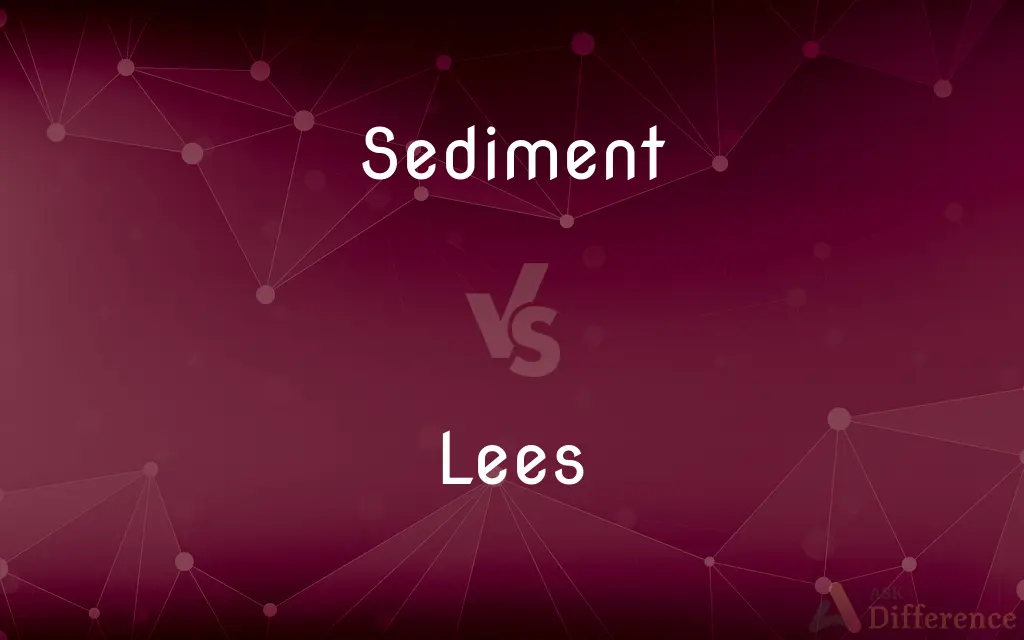Sediment vs. Lees — What's the Difference?
By Tayyaba Rehman & Maham Liaqat — Updated on April 27, 2024
Sediment generally refers to any particulate matter that settles at the bottom of a liquid, often seen in natural water bodies; lees specifically denotes sediments in wine or other alcoholic beverages after fermentation.

Difference Between Sediment and Lees
Table of Contents
ADVERTISEMENT
Key Differences
Sediment encompasses a broad range of particulate matter, including sand, silt, clay, and organic material, typically found at the bottom of bodies of water due to natural deposition processes. Whereas, lees specifically refers to the deposits that accumulate at the bottom of wine and other alcoholic beverages during and after fermentation. These deposits are primarily composed of dead yeast cells and other byproducts of the fermentation process.
Sediments can form through various natural mechanisms such as weathering of rocks and erosion, contributing to diverse ecosystems in aquatic environments. On the other hand, lees result from the intentional process of fermentation in winemaking, influencing the flavor, texture, and aroma of the final product.
In environmental science, the study of sediments is crucial for understanding sedimentation rates, pollution levels, and ecological impacts on water bodies. Conversely, in viticulture and brewing, lees are studied for their role in enriching flavors and contributing to the mouthfeel and complexity of wines and beers.
While sediment can be found in virtually any natural water setting, such as rivers, lakes, and oceans, lees are confined to the production environments of breweries, wineries, and distilleries. This distinction points to the differing roles and contexts in which these substances are considered and managed.
Sediment management often involves considerations of water clarity, ecosystem health, and pollution control. In contrast, the management of lees is focused on culinary applications, particularly in enhancing the sensory qualities of alcoholic beverages.
ADVERTISEMENT
Comparison Chart
Definition
Particulate matter that settles at the bottom of a liquid.
Sediments that specifically form in alcoholic beverages.
Composition
Sand, silt, clay, organic material.
Dead yeast cells, residual sugars, and other fermentation byproducts.
Source
Natural processes such as weathering and erosion.
Fermentation process in the production of alcoholic beverages.
Context of Use
Environmental science, water management.
Winemaking, brewing industries.
Impact
Affects water clarity, ecosystem health, pollution levels.
Influences flavor, aroma, and texture of beverages.
Compare with Definitions
Sediment
Material that settles during the storage or processing of liquids.
The sediment in our water tank needs to be cleaned out periodically.
Lees
Sediment of wine or beer left after fermentation, containing mainly yeast.
Lees are often stirred back into wine to enhance flavor.
Sediment
A deposit of insoluble particles within a solution.
There was visible sediment in the old paint can.
Lees
The deposits at the bottom of barrels or bottles in winemaking.
The winemaker decided to age the wine on its lees to add complexity.
Sediment
Solid material that accumulates on the bottom of liquid due to gravity.
Sediment at the bottom of the river often includes sand and clay.
Lees
Residual yeast and particles in fermentation vessels.
Filtering the lees out of the beer ensures a clear final product.
Sediment
The accumulation of organic and inorganic material at the bottom of aquatic systems.
Analyzing lake sediment helps scientists track environmental changes.
Lees
The sediment specific to alcoholic drink production, affecting taste and texture.
Some brewers retain the lees in the bottle to continue maturing the flavor.
Sediment
Particles that are transported by water, wind, or ice and deposited in a new location.
Glacial sediment was crucial in forming the landscape.
Lees
The byproduct of fermentation used in culinary applications.
The chef used lees from wine-making to create a rich, flavorful sauce.
Sediment
Sediment is a naturally occurring material that is broken down by processes of weathering and erosion, and is subsequently transported by the action of wind, water, or ice or by the force of gravity acting on the particles. For example, sand and silt can be carried in suspension in river water and on reaching the sea bed deposited by sedimentation; if buried, they may eventually become sandstone and siltstone (sedimentary rocks) through lithification.
Lees
The sediment that settles during fermentation of beverages, consisting of dead yeast and precipitated parts of the fruit.
Sediment
Matter that settles to the bottom of a liquid; dregs
The ice freezes the wine and sediment at the base of the cork
Lees
Dregs. See 2d Lee.
Sediment
Settle as sediment
The erythrocytes were allowed to sediment within the syringe
Lees
A leash.
Sediment
Material that settles to the bottom of a liquid; lees.
Lees
The sediment from fermentation of an alcoholic beverage
Sediment
Solid fragments of inorganic or organic material that come from the weathering of rock and are carried and deposited by wind, water, or ice.
Sediment
A collection of small particles, particularly dirt, that precipitates from a river or other body of water.
The Nile delta is composed of sediment that was washed down and deposited at the mouth of the river.
Sediment
(transitive) To deposit material as a sediment.
Sediment
(intransitive) To be deposited as a sediment.
Sediment
The matter which subsides to the bottom, from water or any other liquid; settlings; lees; dregs.
Sediment
The material of which sedimentary rocks are formed.
Sediment
Matter deposited by some natural process
Sediment
Deposit as a sediment
Sediment
Settle as sediment
Common Curiosities
What are lees in winemaking?
Lees are the deposits left at the bottom of wine after fermentation, consisting mostly of dead yeast cells.
What is sediment?
Sediment refers to any solid material that settles at the bottom of a liquid, often formed through natural processes like erosion.
How do sediments impact the environment?
Sediments can influence water clarity and quality, affecting aquatic life and ecosystem health.
What role do lees play in winemaking?
Lees contribute to the flavor, aroma, and texture of wine, often enhancing its complexity.
Can sediment be found in drinking water?
Yes, sediment can accumulate in water tanks or pipes and is often a concern in water treatment.
Is it safe to consume lees?
While lees are generally filtered out before bottling, they are non-toxic and can be consumed safely.
What are the ecological roles of sediment?
Sediment layers can create habitats and provide nutrients for various aquatic organisms.
What are common techniques for sediment analysis?
Techniques include sieving, chemical analysis, and microscopy to study particle size and composition.
How can lees affect the shelf life of a beverage?
Lees can protect against oxidation, potentially extending the shelf life of certain wines.
What methods are used to manage sediment in natural bodies of water?
Methods include dredging, sediment traps, and vegetation buffers to prevent excessive accumulation.
How are lees handled in breweries?
In breweries, lees are typically removed to avoid off-flavors, although some beer styles embrace lees for added character.
Are sediments always harmful to water systems?
Not necessarily; while excessive sediments can be harmful, normal levels are crucial for many aquatic ecosystems.
Why might a winemaker choose to age wine on lees?
Aging on lees can enhance the wine’s body and introduce secondary flavors and creaminess.
What types of sediment are there?
Types include organic, inorganic, coarse, and fine sediments, each with different characteristics and effects.
Do lees vary by type of alcoholic beverage?
Yes, the composition of lees can vary depending on the type of drink and fermentation conditions.
Share Your Discovery

Previous Comparison
Meeting vs. Briefing
Next Comparison
Internist vs. SurgeonAuthor Spotlight
Written by
Tayyaba RehmanTayyaba Rehman is a distinguished writer, currently serving as a primary contributor to askdifference.com. As a researcher in semantics and etymology, Tayyaba's passion for the complexity of languages and their distinctions has found a perfect home on the platform. Tayyaba delves into the intricacies of language, distinguishing between commonly confused words and phrases, thereby providing clarity for readers worldwide.
Co-written by
Maham Liaqat













































